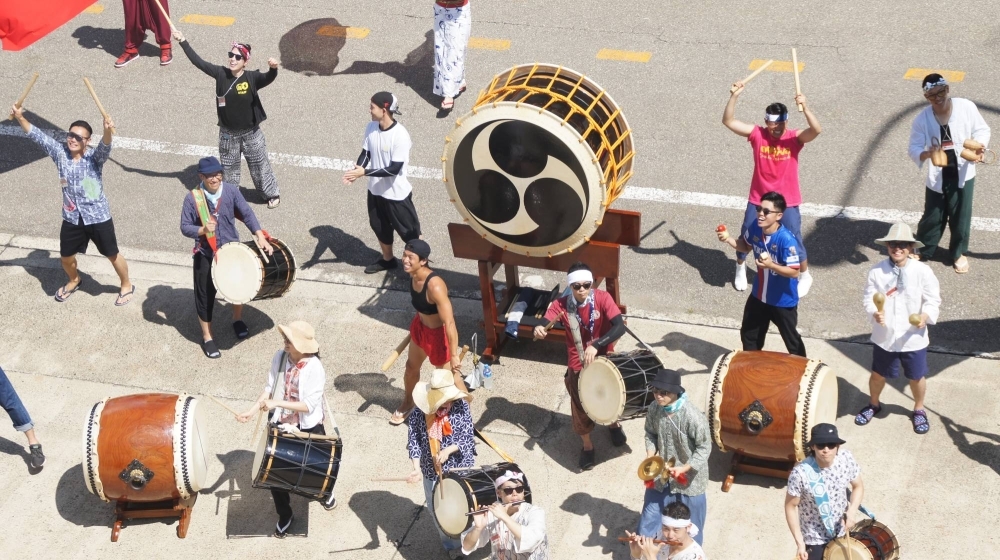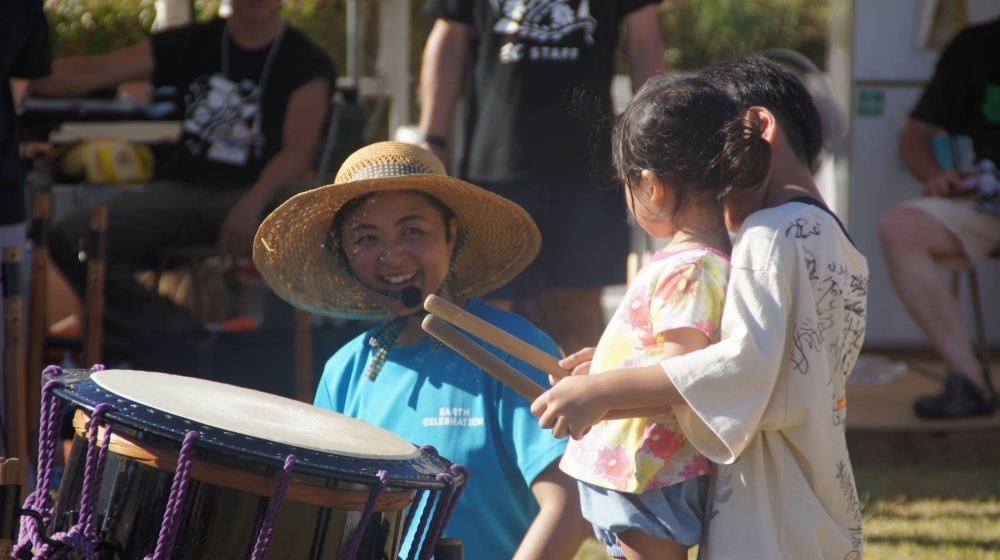Masami Miyazaki’s lean legs ripple with muscle; her strong, sinewy forearms swing upward through the air. She draws a grounding breath in, chest expanding. The bachi drumsticks beat down powerfully on cowhide stretched taut over a wooden drum.
The mesmerizing booming sound of the taiko drum echoes the beat of Miyazaki’s heart.
Historically, it has usually been a man standing in front of the mighty taiko. A woman’s role was reserved for singing or dancing, their bodies judged incapable of meeting the demanding physicality of playing taiko.
But the future of taiko looks loudly female, with taiko groups around the world claiming more women than ever before are taking bachi in hand. Through taiko performances, Japanese women are redefining cultural stereotypes, one drumbeat at a time.
For 25 years, Miyazaki has been a member of Kodo, a taiko ensemble based on Sado Island off the coast of Niigata Prefecture. She works at the island’s Tatatokan performance and training center, where she holds taiko drumming workshops for the public as a member of the Kodo Cultural Foundation. Until 2013, Miyazaki also traveled with Kodo on the group’s overseas tours, but she calls Sado her home now.
Sado Island is often called the home of kumi-daiko (ensemble taiko performances) after musician Den Tagayasu started to teach the art of taiko to young men on the island in the early 1970s. But now, women are committing to the taiko lifestyle, too.
Miyazaki says it was seeing a taiko drum performance at a local festival in her hometown of Kumamoto when she was young that made her want to take up her own bachi. After this, Miyazaki started to learn at Kodo’s training institute.

As part of the Earth Celebration held on Sado Island, an all-female section of the Kodo troupe performed for onlookers.
| COURTESY OF TAKASHI OKAMOTO
Kodo is one of the most well-known taiko ensembles in Japan. The name comes from two meanings; “children of the drum” and “heartbeat,” the primal source of all rhythm. The sound of the taiko drum is even thought to be reminiscent of a mother’s heartbeat as felt in the womb. It makes metaphorical sense for women to stand proud holding two bachi.
Taiko are thought to have been introduced to Japan as early as the 6th century; their function ranged from instruments in religious ceremonies, military field music and general festivities. Kumi-daiko performances with multiple people playing on different drums, such as Kodo, were developed in the 1950s, primarily by male leaders. Women taking part in Kodo’s early recitals only performed dance routines.
“The main expectation back then was that only strong males can drum,” says Miyazaki of joining Kodo in 1998. “I felt unwelcome even though women can hit taiko drums hard.”
The first female drummers in Kodo had only begun to take to the stage in the late 1980s, at least seven years after the ensemble was established. When Miyazaki joined Kodo, there were six female performers.
“The challenge now is how to express ‘a woman’s earnest attitude,’” she says. “If you just hit recklessly, you won’t be evaluated in the same way as men. It is necessary to devise ways to beat, hold your posture and show certain facial expressions.”
Miyazaki says she only began to feel welcome 10 years after joining Kodo.
“Then, I was praised for my powerful taiko drumming as a woman on an overseas tour,” she says. “Times have changed now.”
Now, when Miyazaki performs in front of a large crowd, she feels a part of what she calls, “a community of empathy.”
“There are times when I feel that the sound of taiko drums unites everyone’s feelings,” she says. “When the whole venue is wrapped in the same atmosphere, I get very excited.”
New generation
Mizuki Yoneyama, 29, first picked up a set of bachi at just two years old when she participated in a local Bon festival. A few years later came a chance encounter with Kodo.
“I saw Kodo for the first time when I was in elementary school, and I admired a female player that was performing,” says Yoneyama. “Seeing her dignified, strong and beautiful figure, I was so moved that I decided to become a professional taiko drummer, too.”
Growing up in Tokyo’s Ota Ward, Yoneyama studied performing arts, majoring in theater. But for the past eight years, she has traveled around Japan and the world, including stops in Russia, Indonesia and the United States, as a member of Kodo.
As part of a newer generation of female taiko drummers, Yoneyama says she has never been largely conscious of her gender when performing.
“Of course, there are inevitable physical differences in muscles, power and the volume of the taiko sound, but I always aim for what ‘my taiko’ would be, rather than what I can be as a female performer,” she says. “Gender was never a factor for me, and in fact, being born as a woman only makes me more unique as an individual.
“In Kodo, I have no desire to be competitive with the group’s male performers. Instead, I am constantly pursuing the charm that only I can bring out myself.”
In her travels, she has met many female taiko drummers — especially in the U.S. Women of Japanese ethnicity born or living overseas, Yoneyama says, sometimes turn to taiko to rediscover and connect with their roots.

At Sado Island’s Earth Celebration, taiko players even bid farewell to audience members departing on a mainland-bound ferry.
| COURTESY OF NIKOLA NERAL
In Kodo’s current tour, Yoneyama is now a featured performer — and the group’s first-ever female player of the odaiko (large drums of more than 90 centimeters in diameter).
“Nowadays, we are in an era where women play the odaiko, but when I joined Kodo, it was still mostly men,” Miyazaki says.
Although Kodo still has double the number of male to female performers, International Tours and Projects Production Manager Yui Kamiya says that when you look at the taiko-playing community globally, there are more women than men.
“We have been seeing many more women who have shined on and off stage playing taiko, and at Kodo we are proud to have our female performers leading and continuing to strive as amazing drummers on stage,” Kamiya says.
“They continue to evolve and thrive within the ensemble thanks to the first female performers who pushed to play taiko on stage alongside their male counterparts in Kodo’s early days.”
Drumming along
Sado Island is home to one of Kodo’s biggest annual events: the Earth Celebration. From Aug. 18-20, an estimated 23,000 people gathered on the island to dance under the sun to the beat of taiko.
The first Earth Celebration was held in 1988, an exchange of art and music set on Sado’s stage of natural beauty. Kodo’s first managing director Toshio Kawauchi created the event as “an experiment in strengthening the community ties of all the Earth’s inhabitants.”
Many female taiko drummers are now center-stage of Earth Celebration, and festival-goers of all ages and genders are invited to take part in impromptu jam sessions.

A natural product of more professional female taiko players is a new generation following in their footsteps.
| COURTESY OF NIKOLA NERAL
“It’s not that it’s important just for women to learn, but everyone has an equal right to learn,” says Miyazaki.
“I feel the space that Kodo and the taiko community provides is becoming a more welcoming and open space for people of all genders and of various cultural backgrounds,” says Kamiya. “We are noticing that there are more women who enjoy playing taiko as part of local groups or classes, too.”
Earlier this year during Golden Week, I traveled to Sado Island and visited Tatakokan. I was greeted by two enormous taiko, each handcarved from a 600-year-old Japanese Zelkova tree. With bachi in hand, I beat down on one of the taiko — the loud boom reverberated throughout both my body and the wooden-beamed, light-filled room. At first hit, I felt weak, a bit timid, but with each new strike, a rhythm slowly took over me.
“In this day and age, not only in the community of taiko, but throughout the world as a whole, I feel that women are increasingly becoming the main players in various fields,” says Yoneyama. “And that reflects back on Japanese culture as well. I am very happy about that.”
